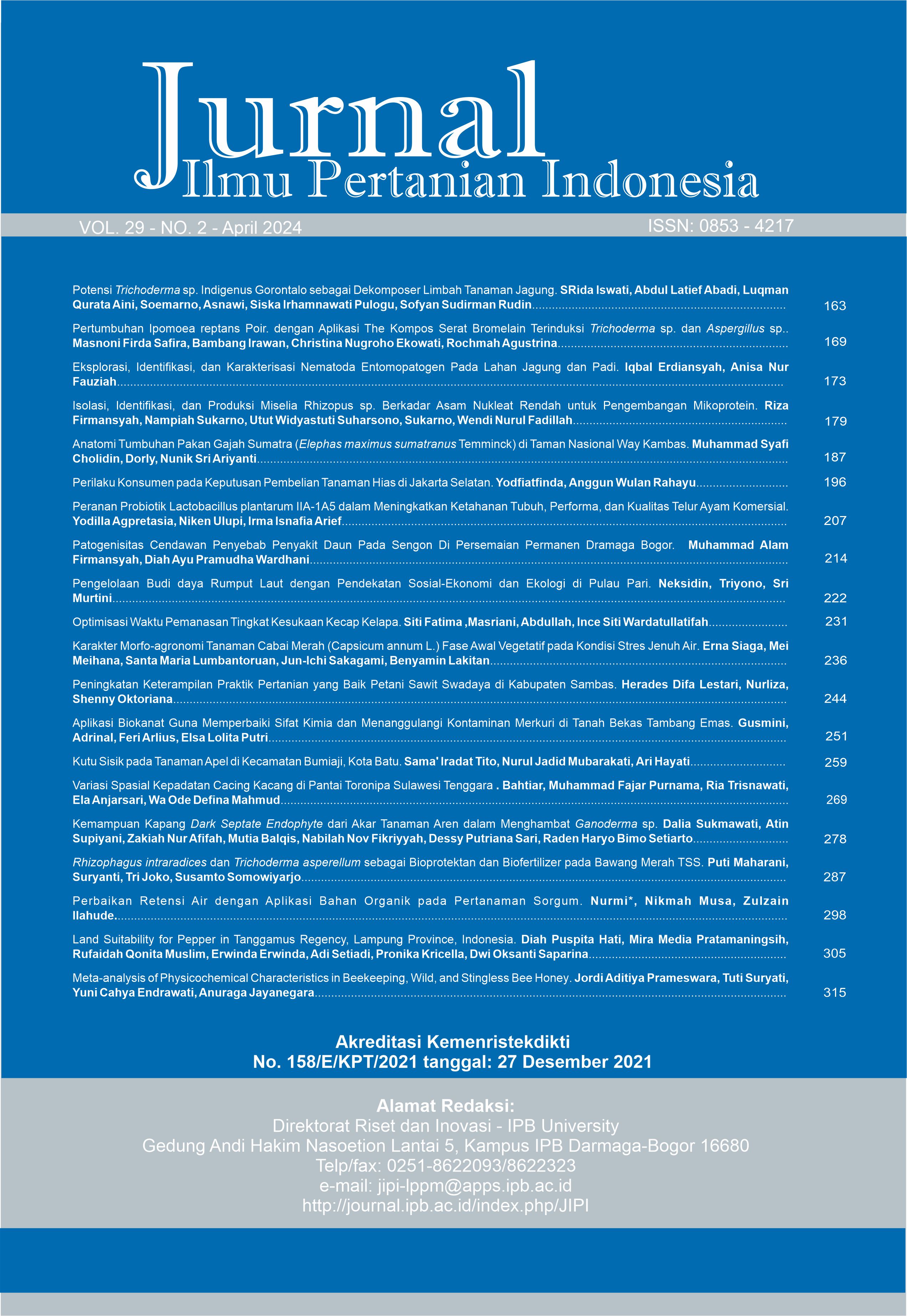Isolasi, Identifikasi, dan Produksi Miselia Rhizopus sp. Berkadar Asam Nukleat Rendah untuk Pengembangan Mikoprotein
Abstract
Fungi, including Rhizopus sp., are food sources that commonly contain high nucleic acid levels. Therefore, the nucleic acid content must be reduced to achieve health standard requirements. This study aimed to isolate, identify, and produce Rhizopus sp. mycelium containing low nucleic acid. The Rhizopus spp. were isolated from tempeh collected from 12 different areas in Indonesia. Fungal identification was conducted based on morphological characteristics. The fungal isolates were selected based on mycelial growth and spore production on PDA. Biomass production of mycelium was carried out in potato extract and soybean extract media obtained from 200 g/L and 333.3 g/L, respectively. In each medium, 6 sugar levels were added, namely 0, 2, 3, 4, 5, and 6 g/L. Mycelium nucleic acid content reduction was achieved by heat treatment at 50°C and 60°C for 15 minutes and measured by a spectrophotometer at 260 nm. Fifty-eight isolates that were identified into 3 species were obtained in this experiment: R. oryzae, R. stolonifera, and R. microsporus. R. Microsporus had higher mycelium biomass and lower spore number than the other species. R. Microsporus produced a higher mycelium biomass in the soybean extract medium with 5 g/L additional sugar. The nucleic acid content of the 50°C heat-treated mycelium was 1.82% and 1.73% at 65°C. These values fulfilled the standard of mycelial nucleic acid content permitted in food by the USDA.
Keywords: morphology, Rhizopus microspores, spore, soybean extract, tempeh
Downloads
References
Ahnan-Winarno AD, Cordeiro L, Winarno FG, Gibbons J, Xiao H. 2021. Tempeh: A semicentennial review on its health benefits, fermentation, safety, processing, sustainability, and affordability. Compr Rev Food Sci Food Saf. 20: 1717– 1767.
Berger RG, Bordewick S, Krahe NK, Ersoy F. 2022. Mycelium vs. fruiting bodies of edible fungi - a comparison of metabolites. Microorganisms. 10(7):1379.
Castro AC, Sinskey AJ, Tannenbaum SR. 1971. Reduction of Nucleic Acid Content in Candida Yeast Cells by Bovine Pancreatic Ribonuclease A Treatment. J Appl Microbiol 22:422-427
Chipper MAA, Stalpers JA. 1984. A Revision of the Genus Rhizopus. 2. The Rhizopus microsporus group. Stud. Mycol 25: 20-34.
Derbyshire E. 2022. Fungal-derived mycoprotein and health across the lifespan: a narrative review. J Fungi (Basel). 8(7): 653.
Derbyshire EJ, Delange J. 2021. Fungal protein – What is it and what is the health evidence? A systematic review focusing on mycoprotein. Front Sustain Food Syst 5: 581682.
Hartanti AT, Rahayu G, Hidayat I. 2015. Rhizopus species from fresh tempeh collected from several regions in Indonesia.
Huang SJ, Juan HW, Tsai SY. 2017. Content of Purine in Mushroom Fruiting Bodies and Mycelia. Int J Food Eng. 3(2): 95-100.
Kaneko K, Aoyagi Y, Fukuuchi T, Inazawa K, Yamaoka N. 2014. Total purine and purine base content of common foodstuffs for facilitating nutritional therapy for gout and hyperuricemia. Biol Pharm Bull. 37(5): 709-21.
Kirk PM, Cannon PF, Minter DW, Staplers JA. 2008. Ainsworth & Bisby’s Dictionary of the Fungi, 10th edition. Wallingford : CAB International
Nout MJR, Kiers JL. 2005. Tempe Fermentation, Innovation and Functionality : Update Into the Third Millenium. J Appl Microbiol 98 : 789-805.
Ohta S, Maul S, Tannenbaum R. 1971. Characterization of a Heat-Shock Process for Reduction of the Acid Content of Candida utilis. J Appl Microbiol 22 : 415-421.
Othman SI, Mekawey AAI, El-Metwally MM, Gabr SA, Alwaele MA, Al Fassam H, Abo-Eleneen R, Allam AA, Saber WIA. 2022. Rhizopus oryzae AM16; a new hyperactive L-asparaginase producer: Semi solid-state production and anticancer activity of the partially purified protein. Biomed Rep. 16(3): 15.
Rifai MA. 1973. Kunci Kerja Untuk Mendeterminasi Jenis-Jenis Rhizopus di Indonesia. Bogor : Herbarium Bogoriense.
Sambrook J, Russel DW. 2000. Molecular Cloning: A Laboratoty Manual, 3rd ed Vol 3. Cold Spring Harbor Laboratory Press.
Sjamsuridzal W, Khasanah M, Febriani R, Vebliza Y, Oetari A, Santoso I, Gandjar I. 2021. The effect of the use of commercial tempeh starter on the diversity of Rhizopus tempeh in Indonesia. Sci Rep. 11(1): 23932.
Slamet DS, Tarwotjo IG. 1980. Komposisi Zat Gizi Makanan Indonesia. Jakarta : Departemen Kesehatan RI.
Taherzadeh MJ, Fox M, Hjorth H, Edebo L. 2003. Production of Mycellium Biomass and Ethanol From paper Pulp Sulfite Liquor by Rhizopus oryzae. J BioR. Tech 88 : 167-177.
Trinci APJ. 1992. Myco-protein: A twenty-year overnight success story. Mycological Research 96 (1): 1-13.
[USDA] United State Food and Drugs Administration. 1998. Nutrient Data Base for Standard Reference. USA : Quorn Foods Inc.
Yu Q, Guo M, Zhang B, Wu H, Zhang Y, Zhang L. 2020. Analysis of nutritional composition in 23 kinds of edible fungi, Food Quality. 2020: 1-9.
Copyright (c) 2024 Riza Firmansyah, Nampiah Sukarno, Utut Widyastuti Suharsono Suharsono, Sukarno Sukarno, Wendi Nurul Fadillah

This work is licensed under a Creative Commons Attribution-NonCommercial 4.0 International License.
This journal is published under the terms of the Creative Commons Attribution-NonCommercial 4.0 International License. Authors who publish with this journal agree to the following terms: Authors retain copyright and grant the journal right of first publication with the work simultaneously licensed under a Creative Commons Attribution-NonCommercial 4.0 International License. Attribution — You must give appropriate credit, provide a link to the license, and indicate if changes were made. You may do so in any reasonable manner, but not in any way that suggests the licensor endorses you or your use. NonCommercial — You may not use the material for commercial purposes.






















